 By Staff By Staff
September 2, 2016
BURLINGTON, ON
When the province announced earlier this year that beer would be available for purchase at supermarkets Burlington residents wanted to know where they could make a purchase.
The answer at that time was – not in Burlington – Oakville and Hamilton – but not in Burlington.
Yesterday the province announced that wine would be available for purchase at supermarkets – and we made the list – there are a number of supermarkets that will be selling wine as of October 28th.
In its media release the Ministry of Finance said: Ontario has selected the first grocers that could sell both domestic and imported wine inside up to 70 grocery stores across the province, increasing convenience and choice for consumers.
The winning grocers were selected through a competitive bidding process held by the Liquor Control Board of Ontario (LCBO). The sale of wine in grocery stores is scheduled to begin October 28, 2016.
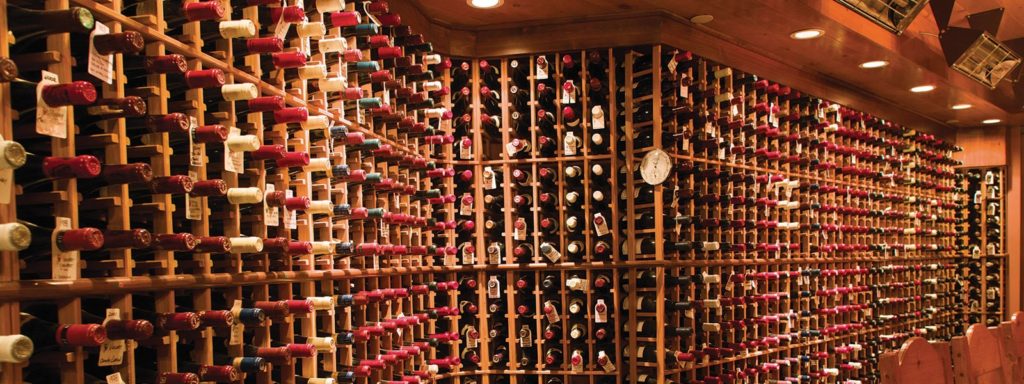 Don’t expect the wine selection in local supermarkets to look anything like this. Reflecting a mix of independent and large grocers and geographic representation to ensure fairness, the successful grocers in the Burlington market are:
Loblaws Inc.
Longo Brothers Fruit Markets Inc.
Metro Ontario Inc.
Sobeys Capital Inc.
Fresh Market Foods
Wal-mart Canada Corp.
Fortinos appears to be missing from the list, however they are part of the larger Loblaws operation – perhaps they will come under that brand name – checking on that.
The other supermarkets that will sell wine in the province are:
Canex Canadian Forces Exchange System
Coppa’s Fresh Market
Farm Boy 2012 Inc.
Highland Farms Inc.
Starsky’s Fine Foods Hamilton Inc.
Uxbridge Foods Inc.
Yummy Market Inc.
These grocers will have to abide by the requirements for the safe sale of alcohol overseen by the Alcohol and Gaming Commission of Ontario (AGCO), including designated sales areas and standard hours of sale, limitations on package sizes and alcohol content and staffing and social responsibility training requirements.
The longer term plan is to eventually have up to 450 grocery stores authorized to sell beer and cider and, of these, up to 300 may also sell wine.
 It will be interesting to see which wines the different supermarkets decide to sell – it will tell us something about how well they know their customer base. Up to 70 existing winery retail stores that operate just outside a grocery store’s checkout will also be permitted to operate inside the store and share the checkout. These “wine boutiques” will broaden their assortment to sell wines made by other Ontario producers, and will be located at grocery stores that sell beer. These wine boutiques will be permitted to begin operating this fall, at the same time as wine is introduced to grocery stores.
Sales of beer in grocery stores started in December 2015. Between December 2015 and the second week of August 2016, grocers received more than 532,000 cases of beer from the LCBO, amounting to net sales of approximately $24 million.

 By Staff By Staff
September 2, 2016
BURLINGTON, ON
There are parts of police work that are just plain hard.
One of those hard jobs is taking place this morning at the Roly Bird Park in Burlington where a cell phone belonging to Christopher Komac was found.
 Christopher has been missing since August 31st when he left his home heading for Prospect and Brant. He has not been seen or heard from by his family since which, for those who know this 23 year old, say “it is very much out of character”. Christopher has been missing since August 31st when he left his home heading for Prospect and Brant. He has not been seen or heard from by his family since which, for those who know this 23 year old, say “it is very much out of character”.
Yesterday the police asked for help in creating a search party to comb the grounds of the park. The response was overwhelming. The police now have “more volunteers than we could have hoped for”
The police have released a poster; Christopher Komac’s whereabouts are still not known.
Updates will be provided when available.

 By Staff By Staff
September 1, 2016
BURLINGTON, ON
The first missing person’s report came in at 7:30 am on September 1st. The Halton Regional Police were seeking the public’s assistance in their search for a missing man.
Christopher Komac was last seen by his family leaving his Burlington residence at approximately 5:30pm on August 31st. He is an avid runner and left his house from the area of Guelph Line and Prospect Street.
Police were notified of his disappearance when he failed to return home.
Mr. Komc’s cell phone has been located in a park near Brant and North Service Road this morning (September 1st) at approximately 7:00am. His whereabouts are currently not known. Police and Mr. Komac’s family members are concerned for his well-being as his disappearance is out of character.
Mr. Komac, 23, is described as male, white, 6’0 tall, 135 pounds, with a slim build. He has brown short hair, brown eyes. He was last seen wearing a blue/green “dri-fit” shirt, royal blue jogging shorts, light grey Nike running shoes with bright green accents and laces.
The search for Mr. Komac began.
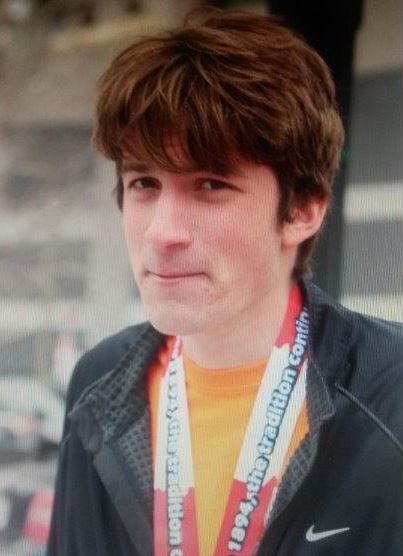 Christopher Komac – missing – cell phone found some distance from where he was expected to be out running. Anyone with information concerning the whereabouts of Mr. Komac is asked to contact Detective Joe Barr at 905-825-4747 ext 2385, Detective Constable Erin Cooper at 905-825-4747 ext 2313 or the on-duty Staff Sergeant at 3 District (Burlington) at 905-825-4747 ext 2310.
Late in the evening of September 1, the police issued a media bulletin saying: “Some members of the public have expressed interest in assisting with search efforts. Those interested are invited to attend the parking lot of “Roly Bird” park on Industrial Drive near North Service Road at 10:00am. A Police Command Post will be at the park and where volunteers will be provided direction accordingly.
Detective Joe Barr is the lead officer on the search for Helen Robertson, 79 year-old Alzheimer’s patient, who went missing on July 5th, and had not been found. Detective Barr is with the Criminal Investigations Bureau of the Halton Regional Police Service.
The police are pulling in every resource to find Michael Komac.

 By Ray Rivers By Ray Rivers
September 1, 2016
MOUNTSBERG, ON
It could be the culmination of all that pollution from (former) Stelco and the other steel company taking its toll on the brain cells of some Hamilton City Councilors.
Or it might be the fact that this city is still almost ungovernable, perhaps even more so after over a decade of forced amalgamation. Or perhaps it is just small-minded political parochialism and old-style partisan politics getting in the way. But Hamilton is on the cusp of saying NO to a billion dollars.
The Province has offered to build a billion dollar light rapid transit system through the downtown core of this rust-belt city at no direct cost to Hamilton. But some Councilors are playing politics.
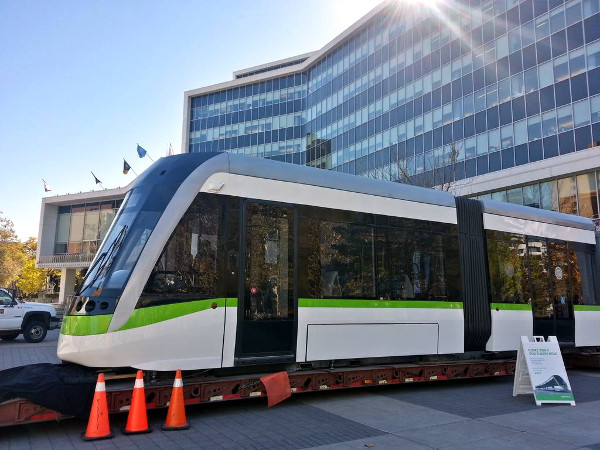 A model of the proposed LRT was placed outside Hamilton city hall for a number of months. Some Councilors who don’t have constituents in the downtown core are looking for a political payoff in order to vote yes to the billion dollar transit gift. That is one of the games in municipal politics, the parochial politician who won’t support anything that benefits other parts of the city unless he/she also gets something in return.
This is a Liberal provincial government making the one-time offer, and it certainly seems that those who support, or once sought election for, another political party are saying no thanks. Is it that they’d rather see Hamiltonians lose the only realistic hope for a rapid transit system in a long time, than see the Wynne government get the credit?
There is a lot of spin by the naysayers. What if the construction costs more than a billion? What if the McMaster University terminus moves and that demand dries up? How will emergency vehicles cross the elevated tracks? Won’t self-driving electric cars and buses make rapid transit obsolete?
 There are plans to develop Pier 8 – putting housing where shipping sheds now stand in the north end of the city. GO train station is within walking distance. Not that building a high speed transit line is without hiccups and annoyances. The line under construction in Kitchener has taken longer than expected and is very disruptive to local residents and businesses. Still the public there have not lost patience nor passion, knowing that the pain is worth the gain.
They understand how the subway in Toronto grew the downtown economy of that city, preventing its decline into the ’60/70’s rust belt which plagued other cities in the Great Lakes basin, including Hamilton. No economic studies have shown a downside for the investment from Hamilton’s perspective. And just about everyone expects that mass transit will provide a much needed kick-start to revitalizing a commercially depleted and desperate downtown Hamilton.
I lived in Vancouver when the Sky Train came into operation. Rapid transit has proven to be one of the best things that ever happened to that city, which would otherwise be choking on the exhaust fumes of its own success, more than it is. Unfortunately Hamilton’s dim-sighted politicians decided against a similar system when it was offered by the Davis government back in the day. Concerns over commuters peeking into residents’ backyards apparently put that project into the waste bin of history.
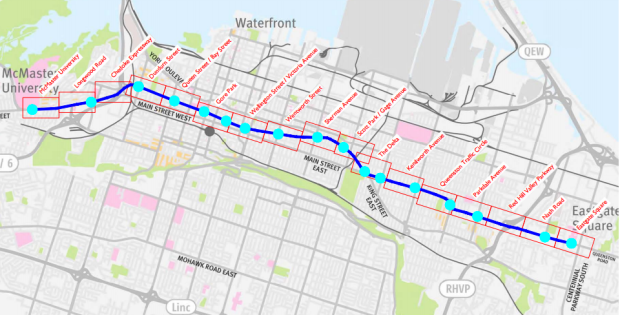 Is it just small-minded political parochialism and old-style partisan politics having Hamilton say NO to a $Billion for an LRT line? I wrote about the last municipal election in this space back in 2014. One of the biggest challenges seen by the mayoralty contestants was getting independent minded Councilors to work as if they were in a team – to focus on what is good for the city rather than just their own ward or their own political ambitions.
Despite his best intentions, that doesn’t seem to be working for Mayor Eisenberger. If Hamilton’s politicians are so determined to only look after their own interests, why were they so enthusiastic about making the city one big community? Perhaps the answer lies in eliminating the ward system and electing the entire council at large.
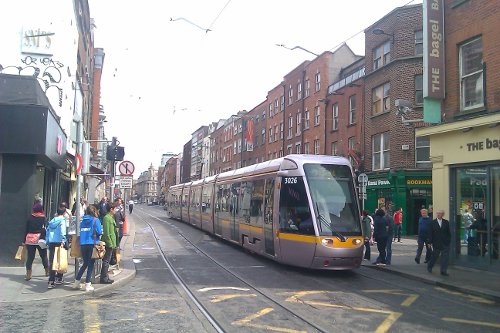 Development has always followed transit – will the planned LRT create a new Hamilton? Of course that billion dollars offered by the Province is not really free. Provincial grants are made up of all our money, collected mainly through provincial income and sales taxes – and there is only ever one taxpayer. So the cost-benefit question is whether there will be at least a billion dollars of increased net economic activity. That seems to be the expectation, and nobody is arguing that this infrastructure investment will be a waste of taxpayer money.
So what is stopping the politicians from getting to yes? The vote is next scheduled for September and I’ll be watching to report on the decision. Are our municipal politicians prepared only to put their particular interests ahead of the general welfare of the city, or do they really believe in the new Hamilton?
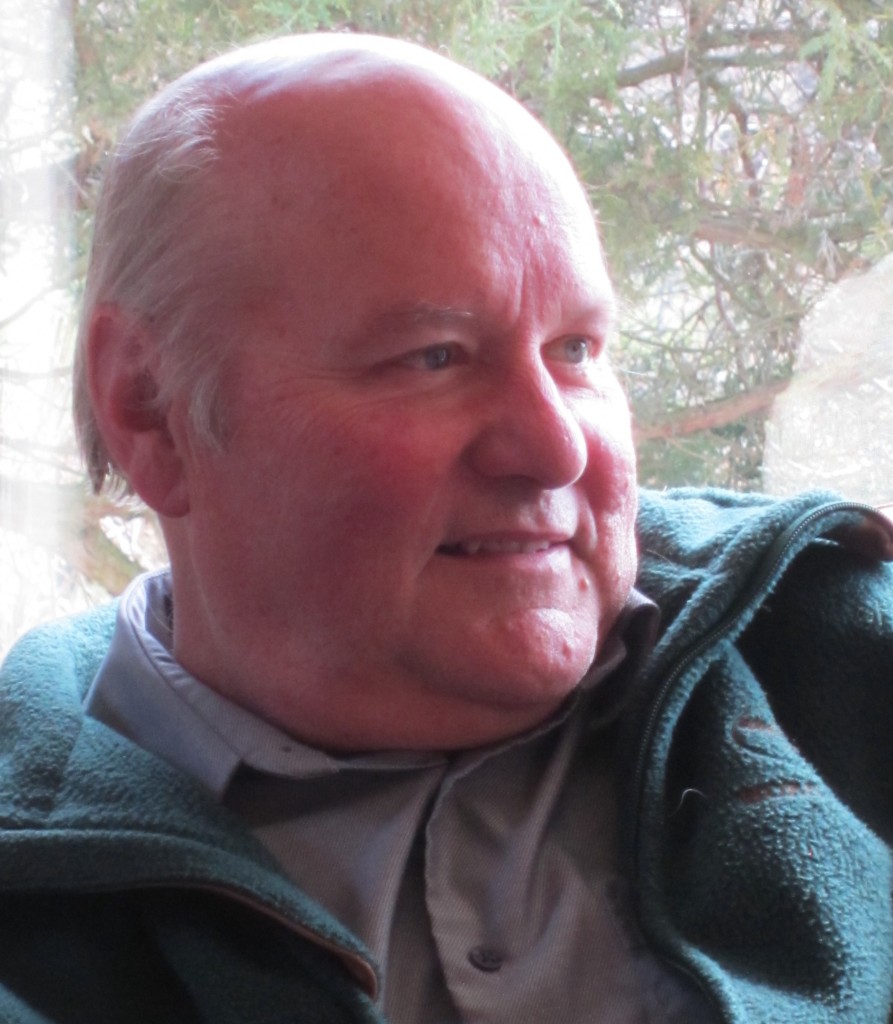 Ray Rivers Ray Rivers is an economist and author who writes weekly on federal and provincial issues, applying his 25 years of involvement with federal and provincial ministries. Rivers’ involvement in city matters led to his appointment as founding chair of Burlington’s Sustainable Development Committee. He was also a candidate in the 1995 provincial election.
Editor’s note: Why would a Burlington paper publish an opinion piece about Hamilton? Because Hamilton is going to be the economic engine that pulls Burlington along with it and knowing what that engine is doing and where it is going tells us where we will end up. The parochialism that exists in Hamilton also exists in Burlington.
Background Links:
Rust Belt – LRT – 10 Questions – Vote Postponed
Waterloo Experience – HSR – Gazette article Oct 2014 –

Burlington’s Member of Parliament, Karina Gould, will be leading a public consultation on Electoral Reform at the Mainway Recreation centre in the auditorium on Saturday September 10th at 12:30.
She wants to hear what her community has to say about the changes Prime Minister Justin Trudeau promised to deliver in the way of electoral reform. During the election campaign Trudeau said that election was the last that would be run under the First Past the Post (FPTP) process Canada has been using since Confederation. What we choose to use as an election process is now a question the public needs to answer.
 By Jay Fallis By Jay Fallis
September 1, 2016
BURLINGTON, ON
This is the 3rd of a 3 part series on electoral reform.
I have explained the First Past the Post (FPTP) system of electing the members of the House of Commons that we use today.
I explained Mixed Member Proportional system, or MMP.
In this system, MMP, each voter receives two ballots. One is used to select the local candidate of their choice, while the other is used to select the party of their choice. The ballots selecting the local candidate are tallied up in each riding, and the candidate with the most votes wins. This is the same in our current system, except that constituencies would be bigger.
With MMP, once the candidate for the constituency is decided, the ballots, which indicate party preference, are tallied and the popular support of each party is determined.
The MMP process distributes a percentage of the seats to each political party based on the percentage of the vote they got; the problem for many people is who, which person, would sit in that seat? Would the political party give the seat to one of its members?
In this article I am going to cover two other possible electoral systems. The first is called Alternative Vote (AV); the second is called the ABC approach to electing people to our House of Commons.
Under Alternate Vote, a voter continues to vote for their local candidates. However, instead of selecting a single candidate with an X, voters order each of the candidates 1-2-3 etc., from their most preferred selection to their least preferred.
When first place selections are counted, a candidate with more than 50% of the popular vote wins. If however no candidate receives more than 50%, then the candidate with the least number of votes is eliminated. The ballots that selected the last place candidate are redistributed using the second selections. This process continues until one candidate receives more than 50% support.
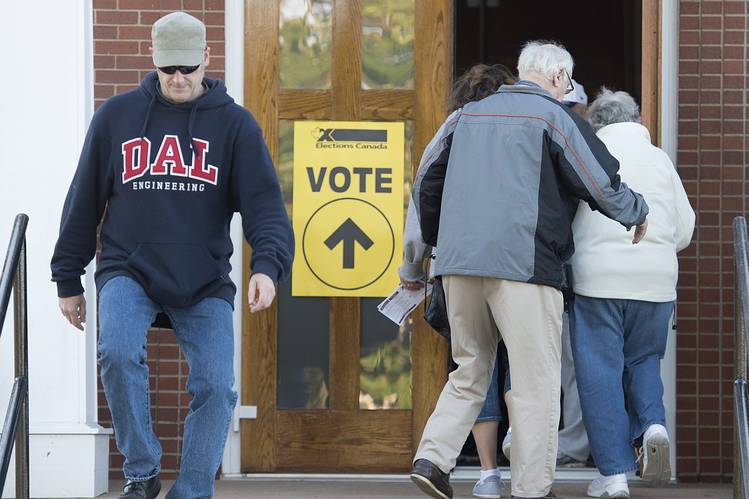 Voter turnout has often been low for the past decade; many people feel the current method of electing members to the House of Commons results in an un-representative form of government. Although this system maintains regional representation as it exists under our current system and allows voters to cast a more accurate ballot, this system has its problems. There is a significant chance it would be advantageous for the Liberal party, as voters on each side of the ideological spectrum have a tendency to select Liberal as their second choice. This could allow Liberal candidates to win in tight ridings more often than not.
Furthermore the method for counting is complex. It would either require days to count by hand or require electronic counting systems. Either method ensures a high probability for error and would be expensive.
Finally, this system would be detrimental for independent candidates and smaller parties. Currently, it is difficult for these candidates and parties to win seats. However, introducing this system would make their advancement even more difficult. This seems unfair when considering that there can be strong independent candidates and viable small parties.
There is another approach – it is referred to as ABC – Alternative Borda Count; developed by French mathematician Charles de Borda.
It is described as easy as ABC (Alternative Borda Count). In this system voters are able to make up to 3 selections: a first, second, and third choice. If voters wish, they can choose to select only a first and second choice, or only a first choice. Each first choice selection is worth 4 points, each second choice selection worth 2 points, and each third choice selection worth 1 point. When the points are tallied and the local candidate with the most points wins.
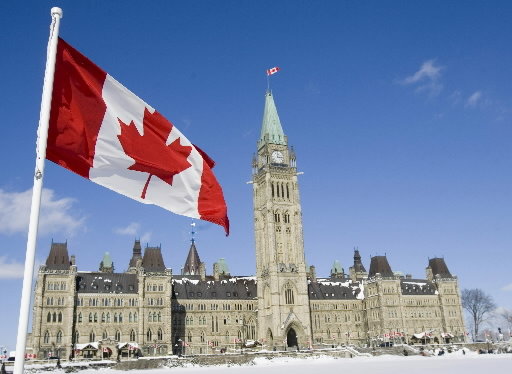 Members of the House of Commons have been determined by First Past the Post elections since confederation. The current government has determined it is time for a change. Although this system does not guarantee perfect representation of votes to seats in the legislature it does represent an obvious improvement from Alternative Vote.
The first advantage is that this system is simple when compared to Alternative Vote. The calculation method and ballot can easily be explained to voters. Additionally, counting can be done relatively efficiently by hand and results could be posted on election night without the use of electronic counting.
This system maintains our country’s current regional representation. All ridings would remain as they are. However, in order to win ridings, candidates would require support from approximately 70 to 80% of the riding’s population. This is much higher than Alternative Vote which would often produce winners with just over 50% of support.
As for independent candidates and smaller parties, this system encourages their advancement. If a candidate or party receives few first place selections, but many 2nd and 3rd place selections they still have some opportunity to win. This will not mean the advancement of many, but it would mean that more independents and small party candidates have the opportunity to win.
Finally, this is a system that has the capability to be popular amongst Canadians. Although it has yet to attract the attention of reform advocates, a preliminary study has shown very high support for the system amongst the voting public. The study I refer to is a paper I did while earning my Master’s degree at the University of Toronto.
Not only does it attract those who support reform, it also attracts many who don’t, because it is simple and offers them the ability to vote as they do under the current system (by choosing to make only a first selection).
ABC is a system that meets many different needs and has the potential to bring about positive change to Canada’s political system when compared to Alternative Vote. To learn more about the ABC system or sign the petition you can go to: abcvote.ca.
I have given readers a quick overview of the different systems that are being considered. The government is now asking Canadians which system they would like to see. It’s an important decision – make a point of getting out to the public meetings and do some research.
Links:
CBC ran a very interesting piece – worth reading.
First of the 3 part series
Second of the 3 part series
 Jay Fallis is a graduate of the University of Toronto where he earned a Master’s Degree that focused on electoral reform. Jay Fallis is a graduate of the University of Toronto where he earned a Master’s Degree that focused on electoral reform.
He writes a column for a daily newspaper in Ontario, the Orillia Packet and Times,

 By Denis Gibbons By Denis Gibbons
September 1, 2016
BURLINGTON, ON
Beautiful green spaces like the Royal Botanical Gardens, LaSalle Park and Burlington Golf and Country Club once made Aldershot the prime place to live in Burlington.
The stretch of Plains Road from King Road west to the border of Hamilton actually is part of the historic Lakeshore Highway, which was the main route between Montreal and Windsor before the QEW and Hwy. 401 were built. The highway attracted a lot of holiday and Sunday afternoon drivers.
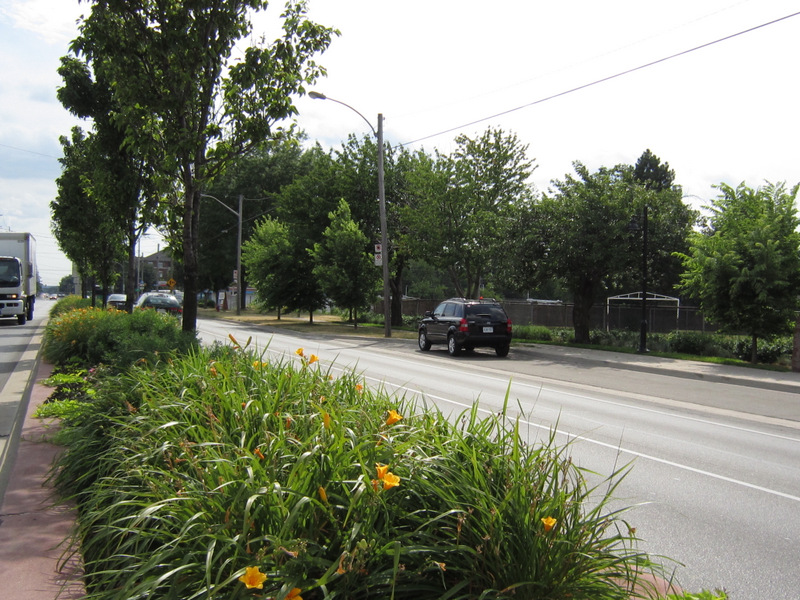 Planters along Plains Road have given what used to be a provincial highway a much more suburban look. Hasn’t slowed traffic down enough for most people – except for those who drive through the community. You’d never know it today with the high rate of development and traffic jams on Plains Road. Some residents are even having second thoughts about staying in the area.
An Aldershot resident, who requested anonymity, said she believes the City is allowing too many multi-level dwellings along Plains Road and has decided to move to Niagara Falls.
“I don’t want to live on the Danforth like in downtown Toronto,” she said. “We don’t have the infrastructure to accommodate it.
“I think we really have to be careful what we’re doing to the lifestyle of the people of Aldershot.”
She said she has exactly 14 seconds to get into the collector lane and make a lefthand turn into her building at 396 Plains Rd. E. and traffic is often backed up in the eastbound lanes.
“The cars are all going 60 and a lot of drivers get mad,” she said.
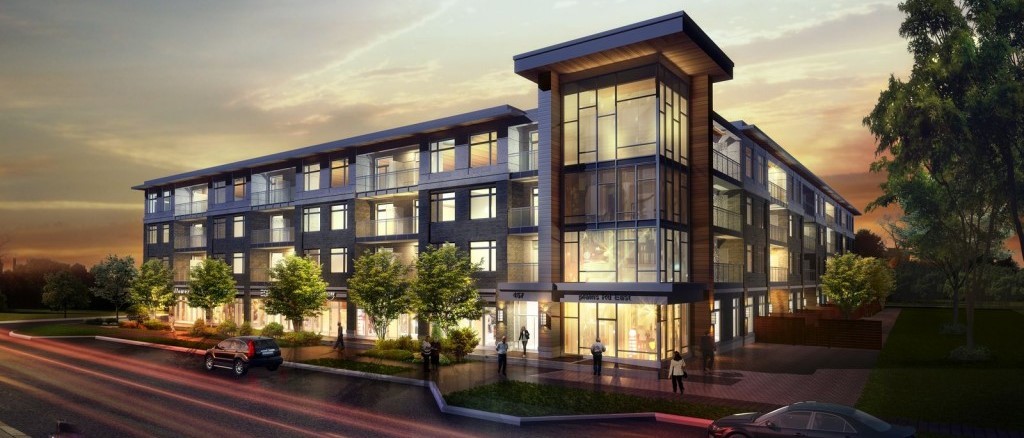 Close to half a dozen residential developments similar to this one, Jazz on Plains Road are being developed. Lou Battiston, who lives on Easterbrook Ave., said he is opposed to all the new apartment buildings going up on Plains Road.
“Adding stores to the bottom of these things without adequate parking is absolutely ridiculous,” he said.
However, he said the increased traffic on Plains Road is not an issue for him.
“I come from Toronto,” he said. “Burlington is still a great place to live.”
Ward 1 Councillor Rick Craven could not be reached for comment by The Bay Observer’s press time, but he has said in the past that whenever new condos are built along the Plains Road corridor senior citizens living in bungalows in Aldershot love to downsize to them.
At the same time, he said, the vacated bungalows are ideal starter homes for young families and this rejuvenates the population.
In July a committee of Burlington city council approved policy directions as guidelines on how the city will grow over the next quarter-century. Under the provincial government’s Places To Grow strategy guidelines, introduced in 2006, Burlington must boost its level of infilling to 40 per cent.
One of the main reasons is to provide adequate accommodation for an increase of immigrants.
Intensification in the portion south of the QEW is the key, since there is not much room left for residential development in north Burlington.
Two of the key areas for intensification are in Aldershot – along Plains Road, which is a major transit route, and close to the Aldershot GO station.
In addition, increased mixed use development is planned near all GO stations as GO bus and train service is extended.
Currently workers are carrying out major improvements to Plains Road East. The work includes paving, as well as new curbs, bike lanes and sidewalks in some parts of the stretch between the QEW and Shadeland Boulevard.
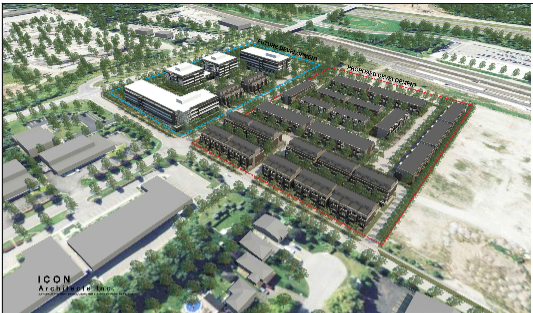 An early architects rendering of the ADI Station West 300 plus development in Aldershot ADI Development Group is proposing construction of over 300 new townhouses near the corner of Waterdown Road and Masonry Court. The project called ‘Station West’ is adjacent to Burlington’s Aldershot GO Station”
Also in the works are the Breeze condos at the corner of Plains Road and Cooke Boulevard and the Affinity Condominiums at the corner of Plains Road and Filmandale Boulevard.
This article first appeared in the Bay Observer.
The Gazette has had a troubling relationship with Councillor Craven. There was a time when we met with him frequently on a confidential basis over lunches at Plucker’s on Plains Road.
There was an occasion at a Conservation Authority meeting when Craven told us that running for Mayor was not out of the question for him – that was before the 2014 election
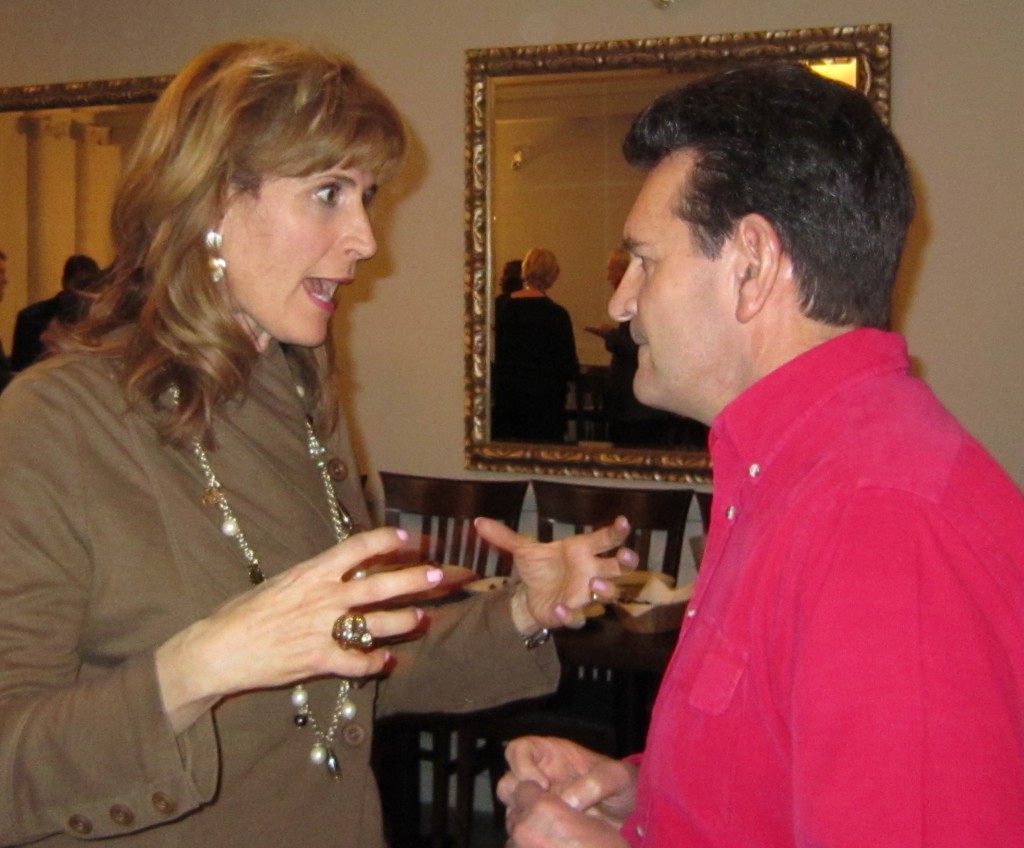 More candidate than Craven could manage? Sandra Pupatello on a trip through town during the xxx Liberal leadership race. At the time Ward 1 Councillor Rick Craven was prepared to let the party romance him. The publisher of the Gazette had some in depth conversations on the idea of his seeking the Liberal nomination for the Burlington seat at Queen’s Park. We convinced him at attend a meeting where he met one of the woman seeking the leadership of the party at that time. Watching Councillor Craven meeting Sandra Pupatello was something to observe.
The Gazette has always described Councillor Craven as the most effective Standing committee chair this city has; he also runs very tight meetings. He understands the Procedural manual better than any other member of council, perhaps even better than the City Clerk.
But a people person he ain’t. Thinnest skin we’ve seen

 By Staff By Staff
August 31, 2016
BURLINGTON, ON
It must have been terrifying.
In the middle of the afternoon there is someone at your door attempting to force their way into your home.
 The image picked up by a security camera may be small but with the technical tools the police have they are able to zoom in and get a considerable amount of information. In this instance Halton Regional Police report that the homeowner was in the house when a female suspect is described as: female white, approximately 50 years of age, light coloured hair (gray or blonde), medium build, 5’3″ to 5’7″ tall, wearing a blue floral button up shirt, gray Capri style pants, black socks and gray converse style shoes made the attempt.
The suspect vehicle involved in the entry is described as a 1998-2001 purple Nissan Altima.
 The police have a clear image of the vehicle used by the suspect – why would a female, thought to be about 50 years of age driving a relatively recent car want to break into a home in the middle of the afternoon? The police were able to get an image from a security camera located in the immediate area.
Nothing was stolen.
Anyone who may have witnessed this incident or has information that would assist investigators are encouraged to contact the Burlington Criminal Investigations Bureau D/Cst Freeman at 905-825-4747 ext 2363 or Det Bale ext 2312 or Crime Stoppers at 1-800-222-8477 (TIPS), or through the web at www.haltoncrimestoppers.com, or by texting “Tip201” with your message to 274637 (crimes).

Burlington’s Member of Parliament, Karina Gould, will be leading a public consultation on Electoral Reform at the Mainway Recreation centre in the auditorium on Saturday September 10th at 12:30.
She wants to hear what her community has to say about the changes Justin Trudeau promised to deliver in the way of electoral reform. During the election campaign Trudeau said that election was the last that would be run under the First Past the Post (FPTP) process Canada has been using since Confederation.
 By Jay Fallis By Jay Fallis
August 31, 2016
BURLINGTON, ON
Part 2 of a 3 part series on electoral reform.
Yesterday, I described the system Canada has been using since Confederation to elect its members to the House of Commons – First Past the Post – FPTP
The Liberal party promised to change this approach during the last federal election. The MP’s are now meeting with their constituents to discuss what the approach should be if not FPTP
A possible approach is referred to as Mixed Member Proportional system, or MMP.
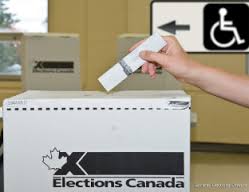 Will a more representative method of electing Members of Parliament result in a higher voter turn out? In this system each voter receives two ballots. One is used to select the local candidate of their choice, while the other is used to select the party of their choice. The ballots selecting the local candidate are tallied up in each riding, and the candidate with the most votes wins. This is the same in our current system, except for the fact that the ridings would be bigger.
Once the local seats are decided, the ballots which indicate party preference are tallied and the popular support of each party is determined by adding up to a total percentage out of 100. In order to ensure that each party has a number of seats reflective of the popular support they received, there are a designated number of seats distributed in accordance with the percentage of each party. In our Parliament it would probably be about 100 seats.
To give you an idea, let us pretend that instead of 338 seats in the House of Commons, there were 200. Of those, 100 would be designated for ridings and the remaining 100 would be designated to ensure that the popular vote is reflected in the Legislature. Let us say that the Liberals won every single riding, yet only amassed 50% of the popular support. Additionally, the NDP and Conservatives were unable to win a single riding seat, but each amassed 25% of the popular support. This would mean that the remaining 100 seats would be divided evenly between the NDP and Conservatives. Thus, the legislature would be reflective of the popular vote because the liberals would have 50% of the seats, leaving the other two parties with 25% each. Regularly there are more seats and parties to make it so that the equation is more intricate, but in essence the way that the seats are distributed is the same.
This explanation begs the question; who will be selected to sit as members in these non-riding seats? One way is to allow voters to choose their favourite representatives of the party for which they voted. The candidates from each party that receive the highest approval ratings would then be selected to fill these seats.
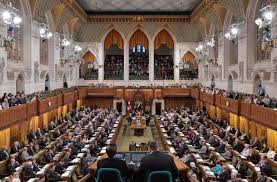 Is it just a matter of putting bums in seats or do we want to find a more representative method of electing Members of Parliament? This concept of “list” seats is probably one of the most controversial aspects of this system. Some support it as voters can elect qualified candidates who would otherwise fail in local ridings. Furthermore, voters of all political stripes throughout the country will most likely have a member that will represent their political interests. On the other hand, critics argue that extended ridings and lack of local affiliation will make it so that MPs will not be as accountable to the electorate.
There is also the issue of conflicting jurisdiction for each elected official. Initially in the Scottish Parliament, the MMP system led to disputes over which Member of Parliament had jurisdiction to handle particular issues thus creating two classes of MP. However, many of these problems could be resolved either through a change in political culture or through modified legislation.
Although MMP is not perfect, it’s most profound advantage is that it ensures that all voters who support different party stripes are adequately represented in the legislature. In this system, almost all votes cast are taken into consideration leaving all parties accurately represented.
As it stands, it seems difficult to perceive that MMP would be introduced without a hitch. It is not the system endorsed by our current Prime Minister, and there is much opposition over certain aspects, especially the presence of the list selection process.
Nevertheless, implementing MMP would certainly produce a Parliament that better represents Canadian voters and be a marked improvement on our current system.
First of a three part series on election reform.
 Jay Fallis is a graduate of the University of Toronto where he earned a Master’s Degree that focused on electoral reform. He writes a column for a daily newspaper in Ontario, the Orillia Packet and Times, Jay Fallis is a graduate of the University of Toronto where he earned a Master’s Degree that focused on electoral reform. He writes a column for a daily newspaper in Ontario, the Orillia Packet and Times,

 By Staff By Staff
August 31, 2016
BURLINGTON, ON
On August 11th 2016 at 4:08am, the suspect captured in this surveillance image entered a vehicle in the residential area south of Tansley Woods in Burlington and stole a wallet.
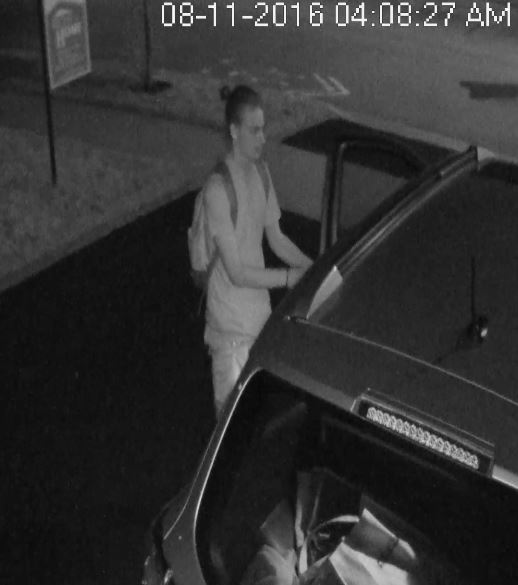 Do you happen to know who this person is? Do you happen to know who this person is?
Anyone who may have witnessed this person or has information that would assist investigators in locating him are encouraged to contact the Burlington Criminal Investigations Bureau D/Cst Freeman at 905-825-4747 ext 2363/Det Bale ext 2312 or Crime Stoppers at 1-800-222-8477 (TIPS), or through the web at www.haltoncrimestoppers.com, or by texting “Tip201” with your message to 274637 (crimes).


 By Pepper Parr By Pepper Parr
August 31st, 2015
BURLINGTON, ON
The Conservation Authority is going through a change – they are calling it a metamorphosis which they define as a “biological process of transformation, differentiation and growth that many species go through as they transition from one life stage to the next.
That is a mouthful.
With a new CAO in place, Conservation Halton, now wants to hear from the public – they want feedback on their strategic plan which includes their Promise, Purpose, Ambition, Guiding Principles and Themes, that frame their priorities and commitment to the environment, communities and customers.
Tucked into that plan are the Key Objectives, Key Enablers and Key Service Targets. These are the changes that Conservation Halton wants to make as an organization and the goals that we will work toward.
They won’t get much in the way of disagreement on any of the above – what they are getting however is a wry look from a public that feels it was not listened to during the reign of the previous CAO.
Conservation Halton is the community based environmental agency that protects, restores and manages the natural resources in its watershed. The organization has staff that includes ecologists, land use planners, engineers, foresters and educators, along with a network of volunteers, who are guided by a Board of Directors comprised of municipally elected and appointed citizens.
Conservation Halton is recognized for its stewardship of creeks, forests and Niagara Escarpment lands through science based programs and services.
 Hassaan Basit, Chief Administrative Officer of Conservation Halton. Hassaan Basit wants to transform Conservation Halton. Vice chair John Vice sees it becoming “a modern organization known in the community for innovation, collaboration, efficiency and service delivery.” They want to position Conservation Halton to deliver effective natural resource management, ultimately leading to improved well-being of our communities.”
“A crucial part of this Metamorphosis is for us to listen to people we serve in the community and find out ideas and thoughts they may have on how we can achieve this transformation. This is why we have embarked on a multi-faceted public engagement between now and the end of September where we hope to connect with people in different ways,” John Vice continues.
The planned public engagement give significant depth to the phrase “multi-faceted public engagement”; there is hardly a base they don’t cover.
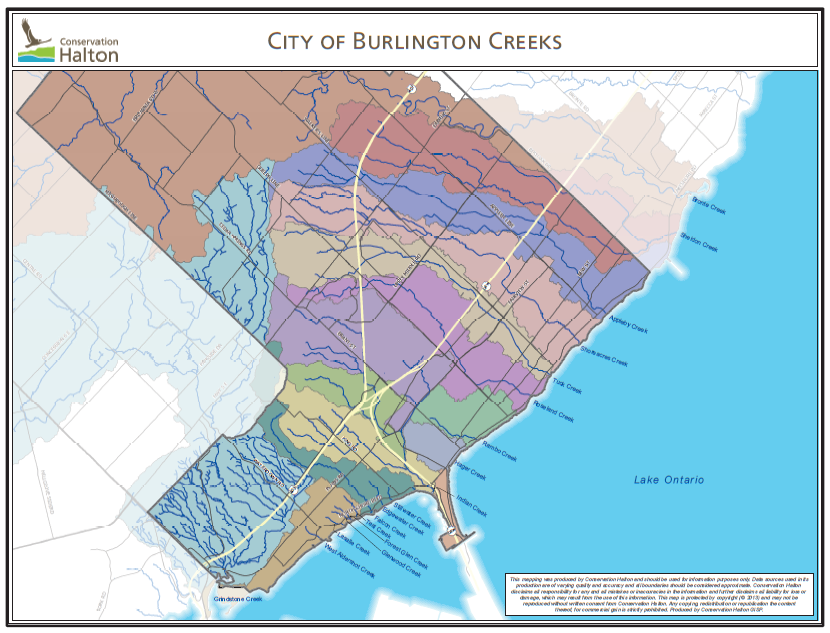 What happens to the watershed in Burlington is job #1 for the Conservation Authority. There are 16 creeks that the Authority keeps a constant eye on – daily. “Owing to our unique position and technical expertise in local watershed science, conservation authorities play a critical role in helping achieve a number of provincial and municipal goals and objectives related to natural resource management, preserving natural and cultural assets, green infrastructure, sustainability and climate change,” says Hassaan Basit, Chief Administrative Officer of Conservation Halton. “As we mark our 60th anniversary later this year and look back at the role conservation authorities have played in the province, it is a reminder of the need to constantly evolve.”
“Conservation authorities respond to natural resource management needs and challenges, even when they change, evolve and intensify, as they have since the Conservation Authorities Act was created. We anticipate that these needs and challenges will continue to change over time, so we must have the strategic agility to continue to adapt,” Hassaan Basit continues.
There are five ways for people to engage with Conservation Halton on Metamorphosis.
1. Attend a Public Open House
The Conservation Authority will be hosting two open houses, where members of the community will have the opportunity to learn more about our strategic directions, comment on our strategic priorities and share ideas for initiatives. Community members interested in attending one or both of the public open houses are asked to register here.
Tuesday September 13
6:00 – 8:00 PM
Conservation Halton Office
2596 Britannia Road, Burlington
Saturday, September 17
10:00 – 12:00 PM
Crawford Lake Longhouse
3115 Conservation Road, Milton
2. Have Your Say in a Survey
We have also created a series of short surveys, which we hope will help us understand the issues that are most important to our community and collect ideas for initiatives regarding these issues. The four survey areas are Sustainable Communities, Environmental Conservation, Climate Change and Outdoor Recreation. Each survey should only take a couple of minutes and responses will be used to shape many of our priorities and efforts. The surveys can be found here.
3. #chlistens on Facebook and Twitter
There will also be many opportunities to engage with us on social media. We will be hosting three open thread discussions on Facebook on September 9, 16 and 23 at 2:00 PM and two live chats on Twitter on September 21 and 28 from 7:00 – 8:00 PM. Look out for the #chlistens hashtag and tune in to chat with us about conservation, climate change and sustainability.
4. Share Your Lunch and #tableyourthoughts
Keep an eye out in the parks for our bright, painted picnic tables! Each picnic table has two chalkboards with the phrase “Conservation to me is…” written on them and park visitors are encouraged to complete the sentence, take a photo of their response and share it on Facebook, Twitter or Instagram with the hashtag #tableyourthoughts. It is our hope that this campaign will inspire real conversations around environmental conservation, climate change, sustainable communities and outdoor recreation.
5. Email Us
Comments can also be sent to web@hrca.on.ca with “Metamorphosis” as the subject line.
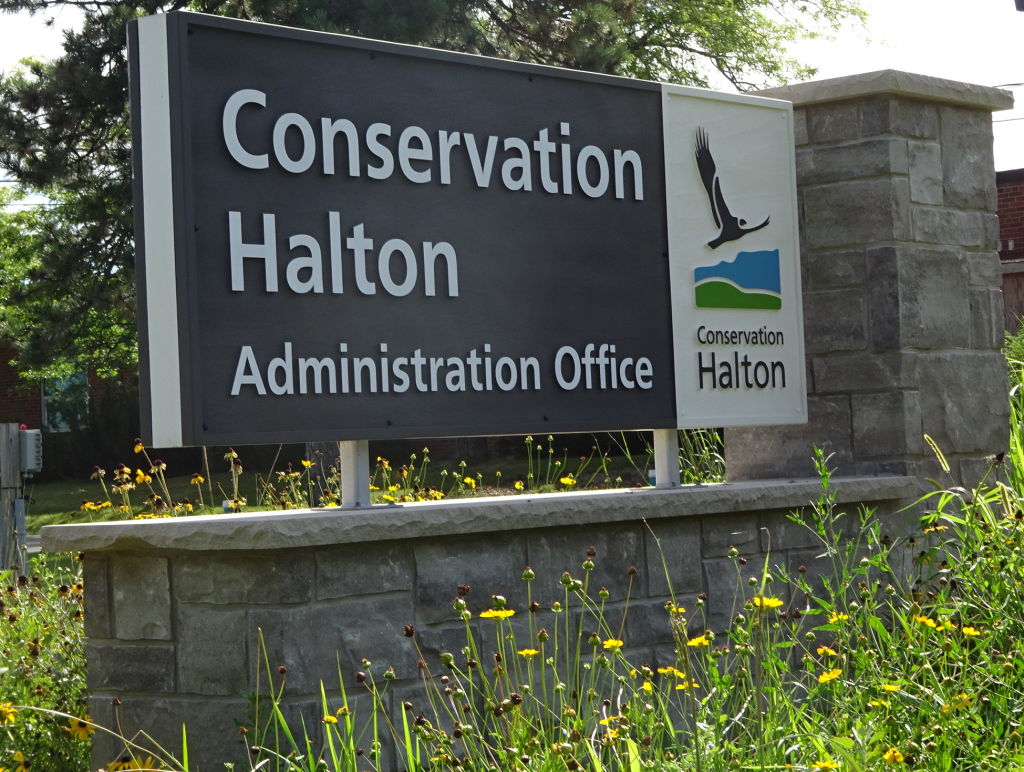 Tucked away in a building that needs some serious upgrades – the staff work at monitoring the watersheds – all 16 of them – and running an extensive educational program and at the same time working at developing the tourism potential of some of the their properties. Conservation Halton staff will also be meeting with key community stakeholders, including our municipal partners, environmental organizations, recreational groups, builders, developers and other members of the business community, in the coming weeks.
For those who live north of Dundas and tried to get permits to do some work on their property all this is close to exciting. The proof of course is in the pudding – but it does look pretty enticing.
Conservation Halton is the community based environmental agency that protects, restores and manages the natural resources in its watershed. The organization has staff that includes ecologists, land use planners, engineers, foresters and educators, along with a network of volunteers, who are guided by a Board of Directors comprised of municipally elected and appointed citizens.
Conservation Halton is recognized for its stewardship of creeks, forests and Niagara Escarpment lands through science based programs and services.

 By Pepper Parr By Pepper Parr
August 30th, 2016
BURLINGTON, ON
The heat is clearly on – staff in the city’s transportation department have taken to thanking people who have used various means of communication to let the city know how they feel about the “road diet” New Street has been put on while the city experiments with dedicated lanes for bicycles on the north and south side of the street between Guelph Line and Walkers Line.
The decision to spend the $250,000 on the pilot project was made by city council July 18th.
It is a change – and people don’t really like change – particularly in Burlington.
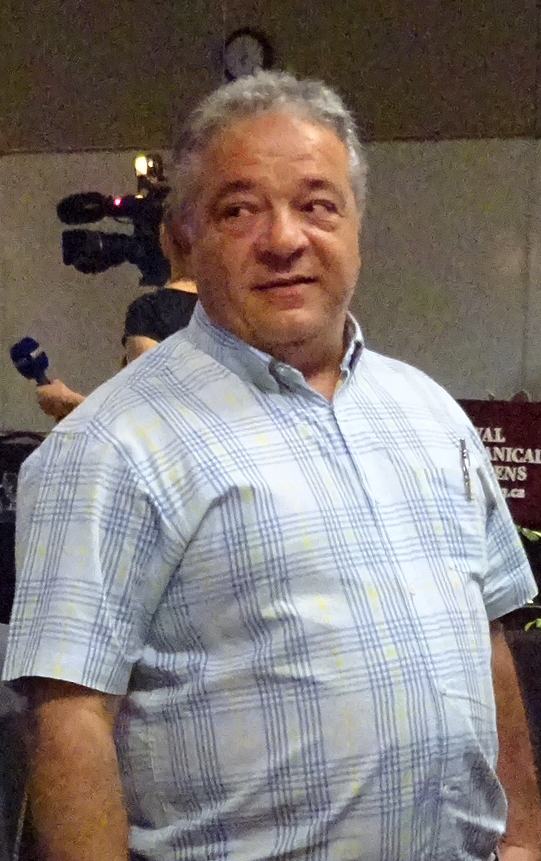 Director of Transportation Vito Tolone is a well informed on transportation matters. What he could not be expected to know was how the public was going to react to the idea of putting dedicated bicycle lanes on New Street. Members of council are supposed to know what their constituents think. In a media release the city said they wanted to thank the hundreds of people who have taken time to comment about the New Street road diet one-year pilot program and assure people that their comments are part of the findings of the pilot.
The Gazette recorded more than 60 comments to which we add the 21 that we did not publish due to the offensive language; some people got very exercised over this one.
It is unusual for city hall to put out a media release – before a project has had a chance to create some data. While there will be data – right now there is just a lot of noise.
Vito Tolone, director of transportation for the city said: “We are hearing what residents have to say, responding to a variety of questions and reading and collecting each comment to include in our pilot findings.” He adds that the “road diet is a one-year pilot program that aims to create a complete street that allows for multiple forms of transportation and enhances the safety of the road for motorists, cyclists and pedestrians.
“Through the city’s strategic plan process, we heard from residents who told us they would like safer places to cycle and more transportation choices when it comes to getting around their city,” said Tolone. “Throughout the one-year pilot, the city is using technology to track all forms of transportation along this stretch of New Street, including cyclists, pedestrians, buses and cars. We will also be collecting data on the average speed travelled and the number of collisions to help us understand how the road is being used.”
 Six of the seven voted for the New Street Road diet – Councillor Sharman voted against the pilot project. Tolone said his department is going to collect “four seasons of data in 2017”; one can only hope that with the uproar, and this is certainly an uproar, that the city will not wait until it has all the data in hand – regular reporting to the public goes a long way to meeting that “transparency and accountability line” that the city trots out regularly.
The pilot looked like a reasonable approach – what neither council nor staff was prepared for was the reaction – most of it before the pilot really had a chance to start. Council voted 6-1 for this (Sharman voted against it – what does he know that the other six don’t know).
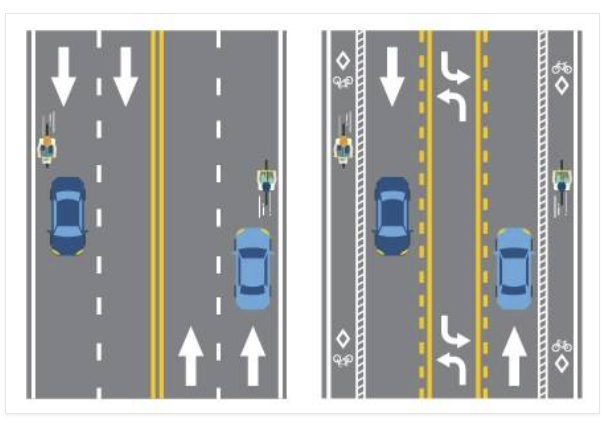 Existing lane configuration on the left – the road diet on the right. New Street is due to get a new asphalt surface in 2017 – council thought this was a good time to do a pilot project before they began laying down the new surface, when the section of New Street between Guelph Line and Walkers Line is scheduled to be resurfaced.
Conducting the pilot project before this work takes place means there will be no added cost to either return the road to its current setup if the pilot is not successful, or to keep the new bike lanes if the pilot program is adopted.
The pilot project now has the distinction of having a page of its own on the city web site. For more information about the New Street road diet, including responses to some of the most frequently asked questions from the community about the pilot, please visit www.burlington.ca/newstreetdiet.

 By Pepper Parr By Pepper Parr
August 30, 2016
BURLINGTON, ON
Teresa’s uniquely sculptural fine art stained glass is an artistic trademark featuring multi layers of glass panels with spun wire. Her use of a refined colour pallet creates a mood and atmosphere that is distinctive to Teresa, making her one of Canada’s most notable emerging stained glass artists whose work is in a number of prominent homes in the area.
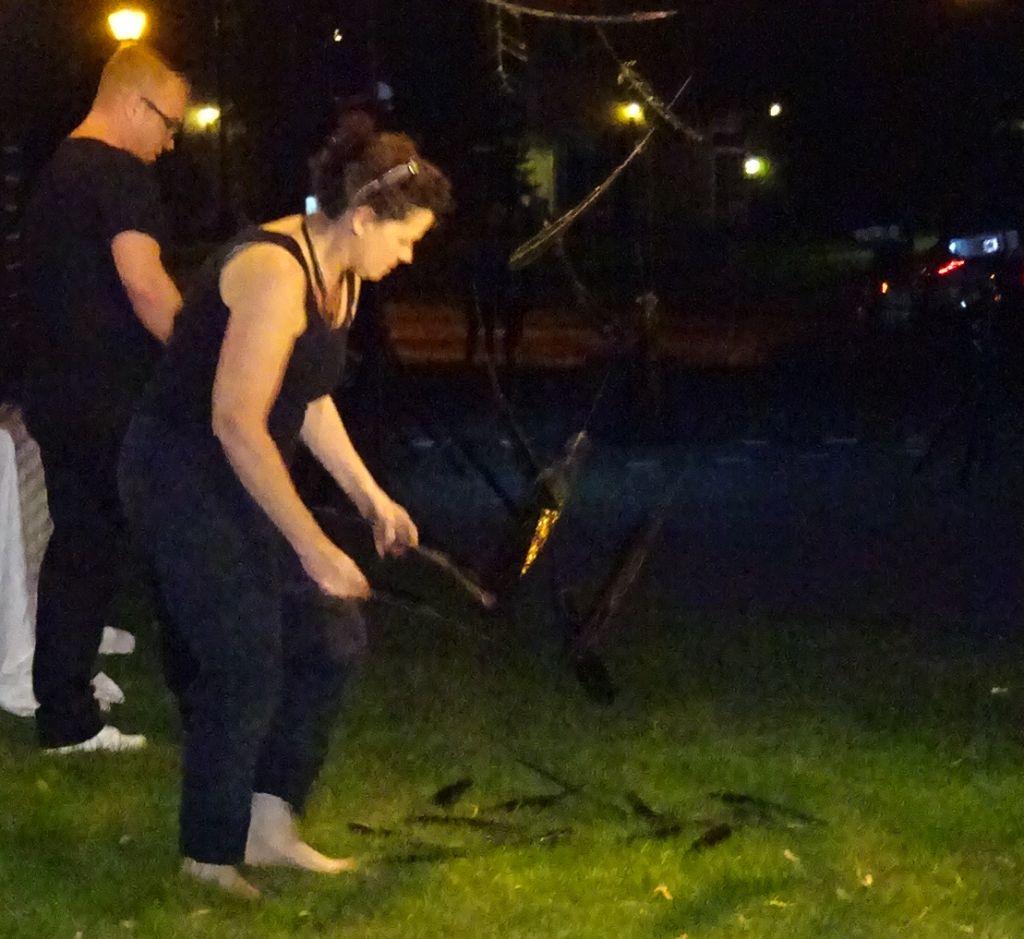 Teresa Seaton and Slam poet Tomy Bewick joined talents to do a remarkably moving installation at the third annual No Vacancy event last year. Seaton is one of 17 artists who will set up her installation for the 7:00 pm opening of the Fourth Annual No Vacancy event taking place on Friday. September 16th at the Art Gallery of Burlington. Each year the No Vacancy events are given a unique name – this year, their fourth they are calling the collection of installation MoonGlade.
Each artist determine how the want to use there art to create a space that you walk into – one doesn’t just look at art hung on a wall – you interact with it.
Jim Riley, an installation artist in hiw one right, as a “three dimensional art form that is often specifically designed to use the walls, floor and space of a room as a sculptural artwork itself. The artist uses objects, video, sound or other material to create the artwork. The audience enters in to the space and becomes part of the actual artwork as opposed to passively looking at one sculpture, one painting one video or other singular artwork.”
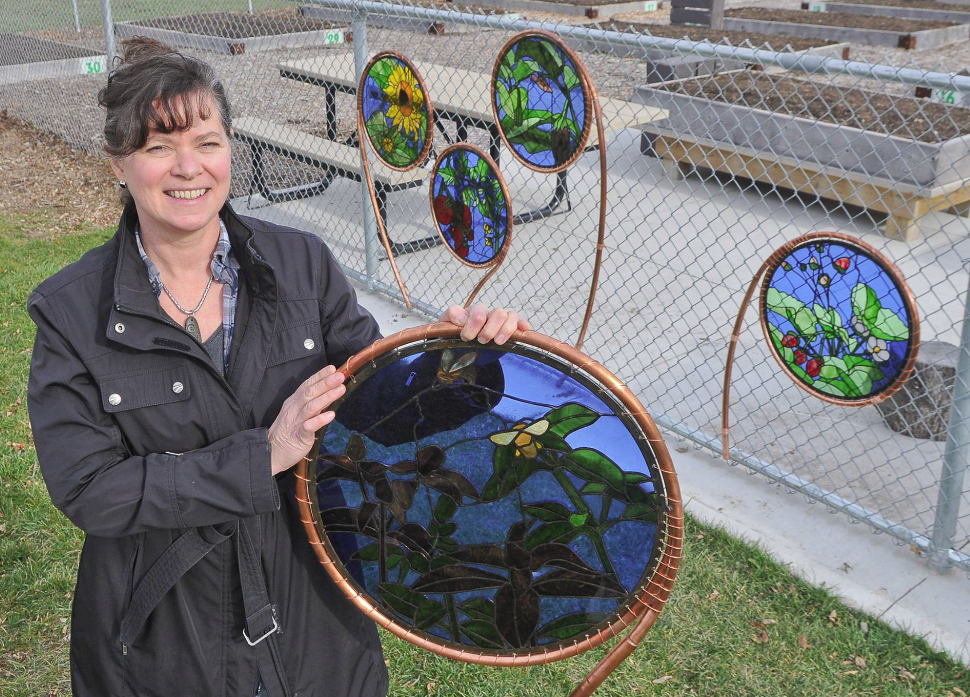 Teresa Seaton was awarded a commission by the city of Burlington to create a piece of public art for ward 3. Seaton graduated from York University, BFA in drawing and sculpture, then completed her Graphic Design Diploma at Sheridan College leading her to successful career as Senior Designer and Creative Director with clients from Toronto to New York.
 Teresa chose stained glass to express her artistic voice in 2001. Working full time as a stained glass Artist she opened the doors of Teresa Seaton Studio & Gallery in 2013. Teresa’s gallery features a large selection of her latest works and now exhibits the work of established and emerging Canadian artists. Teresa chose stained glass to express her artistic voice in 2001. Working full time as a stained glass Artist she opened the doors of Teresa Seaton Studio & Gallery in 2013. Teresa’s gallery features a large selection of her latest works and now exhibits the work of established and emerging Canadian artists.
Last year Seaton worked with Slam poet Tomy Bewick; together they used his poem and Seaton’s stained glass feathers to tell a unique story.
Their performance was close to the best, if not the best installation last year.
Friday, September 17th, 7:00 pm to 11 pm in Brock Park, behind the Art Gallery of Burlington and inside the art gallery as well.

Burlington’s Member of Parliament Karina Gould will be leading a public consultation on Electoral Reform at the Mainway Recreation centre in the auditorium on Saturday September 10th at 12:30.
She wants to hear what her community has to say about the changes Justin Trudeau promised to deliver in the way of electoral reform. The Gazette is publishing a three part series on what the election reform options are.
This is the first of the three parts.
 By Jay Fallis By Jay Fallis
August 30th, 2016
BURLINGTON, ON
If you have been following politics recently you may know that there is a debate currently waging over what type of electoral system Canada should use for the next election. As someone who studied electoral reform I thought it may be valuable to give readers a taste of why our current First Past the Post system needs to be changed. Although there are advantages to First Past the Post: strong regional representation, a simple ballot, an efficient counting method; there are many significant disadvantages.
First and foremost, the number of voters that are represented by FPTP is far below that of the average system. In elections past, support from just over a third of the country has given a party a mandate with 100% of the power. In fact, in the most recent election, despite a landslide victory, the Liberal Party only amassed approximately 39.5% of support from the electorate according to Elections Canada. That means that essentially 60.5% of Canadian voters in 2015 had no say in how their country is going to be governed over the next term.
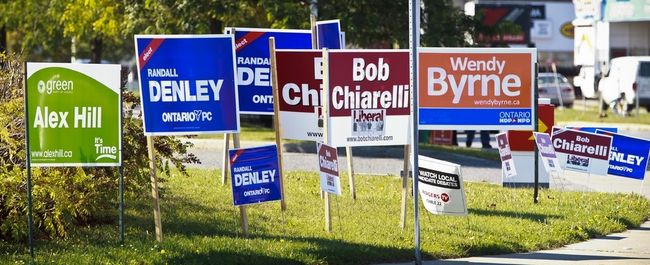 There is seldom a lack of candidates – deciding how we choose the winner is what the public has been asked to voice their views on. This problem is also evident in riding results. Each federal election, there are dozens of cases where an individual candidate will win with 30% to 35% support, leaving the remainder of the voters out to dry. In the 2015 election, there were several instances where this occurred, most notably in the riding of Saint-Hyacinthe—Bagot, Quebec. According to Elections Canada, approximately, 71.4% of those who voted in that riding had no say in the result.
Yes, our First Past the Post system does an excellent job representing each individual region, but how well is it actually representing the voters within these regions? This seems like a relevant question when considering other systems have the ability to represent these regions more adequately.
Along with misrepresentation, the presence of negative electoral rhetoric can be attributed to First Past the Post. Although in 2015 we did see the use of positive advertising surge, the reality is that each party used negative advertising. In our system, voters only get a single selection. It is logical for parties and politicians to use negative ads and sentimentality to show that other parties are not as viable, and that their party is the option to go with.
In all other systems we could choose from, voters are given the ability to make more than one choice. In these alternative systems, politicians and parties no longer have to prove that an opponent is the wrong choice because a vote given to the opposing party will not necessarily mean a lost vote for their own party. Furthermore there is incentive to eliminate negative advertising because it repels strong supporters of other parties who would have the ability to select more than one party under a reformed system. In essence, to adopt reform is to eliminate annoying election rhetoric.
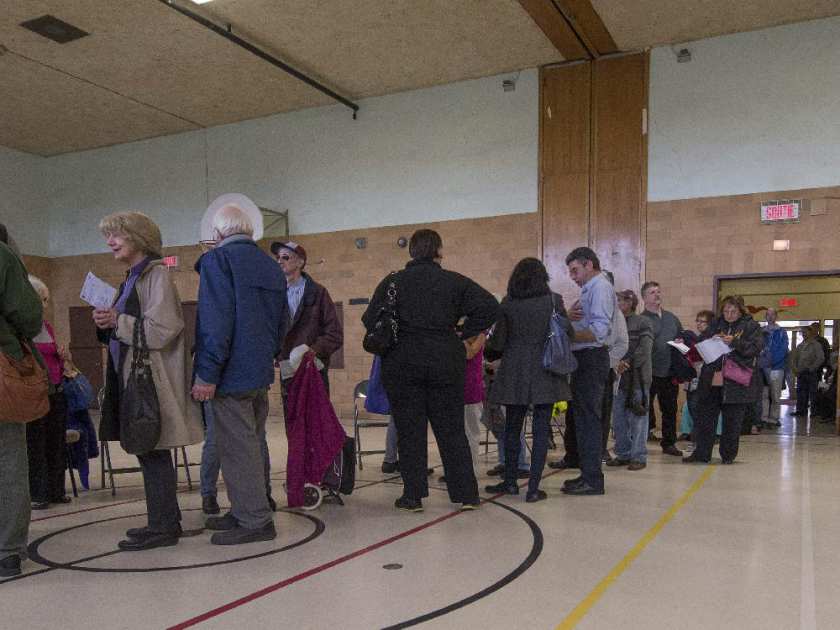 Voters lined up waiting to cast ballots in a school gymnasium Finally, in the past, First Past the Post has produced flawed results. It is one thing for a party to be over represented; it is another for an undeserving party to come to power. An excellent example of this is the British Columbia election in 1997. To make a long story short, the winning party received approximately 2% less support across the province than did the party of the official opposition.
With support more spread out across ridings, the governing party was able to win 6 more seats than the opposition and form a majority government. It is anti-democracy that a party can accumulate the most support yet still lack the ability to govern and have no input in passing legislation. Although a case like this is rare, introducing reform would eliminate such a case from reoccurring.
Change can be unnerving, especially when it involves something as important as how a country is governed. However, when a system is so flawed that it is producing undesirable results to this extent, it should be clear that a change is necessary.
 Jay Fallis is a graduate of the University of Toronto where he earned a Master’s Degree that focused on electoral reform. Jay Fallis is a graduate of the University of Toronto where he earned a Master’s Degree that focused on electoral reform.
He writes a column for a daily newspaper in Ontario, the Orillia Packet and Times,

 By Staff By Staff
August 30th, 2016
BURLINGTON, ON
To accommodate track work at Union Station, GO Transit has made some schedule adjustments beginning Monday, Sept. 5, 2016.
 The current 4:28 p.m. train departing Aldershot GO station will leave three minutes earlier at 4:25 p.m., affecting all station times along this trip. The current 4:28 p.m. train departing Aldershot GO station will leave three minutes earlier at 4:25 p.m., affecting all station times along this trip.
Please adjust your travel plans accordingly. Use tripplanner.burlington.ca or call 905-639-0550 for next bus departure information in real-time.

 By Staff By Staff
August 30th, 2016
BURLINGTON, ON
By gosh and by golly there is another paid holiday coming up for all of us – and that includes those tireless workers at city hall.
A number of the city’s administrative services will be closed Monday, Sept. 5, 2016 for the Civic Holiday.
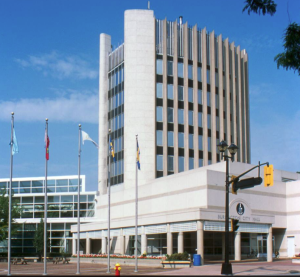 There might be a couple of very conscientious bureaucrats putting in a couple of hours during the holiday weekend – there are more of them you think. City Hall: Will be closed on Monday, Sept. 5, reopening on Tuesday, Sept. 6.
Parks and Recreation Programs and Facilities: Activities and customer service hours at city pools, arenas and community centres vary over the holiday weekend. Please visit www.burlington.ca/calendar for a complete listing of weekend drop-in program times and www.burlington.ca/servicehours for hours at customer service locations.
Burlington Transit and Handi-Van: On Monday, Sept. 5, Burlington Transit will operate a holiday service and the downtown Transit Terminal will be closed. Regular service resumes Tuesday, Sept. 6. The administration offices are closed on Monday, Sept. 5 and will reopen Tuesday, Sept. 6. Call 905-639-0550 or visit www.burlingtontransit.ca for schedule information.
Roads and Parks Maintenance: The administrative office will be closed on Monday, Sept. 5, and will reopen on Monday, Sept. 6. Only emergency service will be provided.
Halton Court Services: Provincial Offences Courts in Milton and Burlington will be closed Monday, Sept. 5.
Parking: Free parking is available in the downtown core, on the street, municipal lots and the parking garage on weekends and holidays.
NOTE: The Waterfront parking lots (east and west) do not provide free parking on statutory holidays.
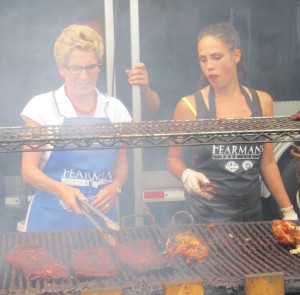 On the left – that is the Premier of our province flipping those Fearman’s ribs at a recent Rib Fest, she told a Gazette reporter that she also knows how to make an apple pie. Rib Fest takes place get dates – make some time to chomp of those ribs and enjoy the day with friends.


 By Staff By Staff
August 29, 2016
Burlington, ON
As the summer winds down and parents are counting down the days till their children return to school, Halton Regional Police are looking forward to a safe start to the school year.
The ninth annual Project Safe Start will run between Monday, August 29 and Tuesday, September 13, 2016. The focus of this traffic campaign is to educate and remind everyone to take extra care when driving and to look out for children in school zones, residential areas, playgrounds and parks.
Halton Regional Police’s goal is to raise awareness about how to keep our children safe on the roads through high-visibility enforcement of traffic laws in and around school zones throughout Halton Region.
To keep children safe while heading to and from school it is important to remember the five Safe Start “S’s”:
1. Safe speeds – Watch for the flashing 40km/h zones. Motorists are required to slow down where school zone signs are posted. Fines increase within many of these zones within Halton Region.
2. Seatbelts – Drivers and passengers should always buckle up on every trip. Seat belt use saves lives and reduces injuries in motor vehicle collisions.
3. School zones and school buses – Slow down and take extra care to look out for children in school zones and residential areas. Red flashing lights and an extended stop sign arm signals that the school bus is stopped and traffic in *both directions* are required to stop for students entering or exiting a school bus.
4. Stop signs – Motorists must come to a complete stop at a red stop sign. Allow time to stop, think, observe and proceed.
5. Safe operation – Distracted driving is dangerous. Motorists should follow the rules of the road and operate their vehicles safely. Drive now and text later!
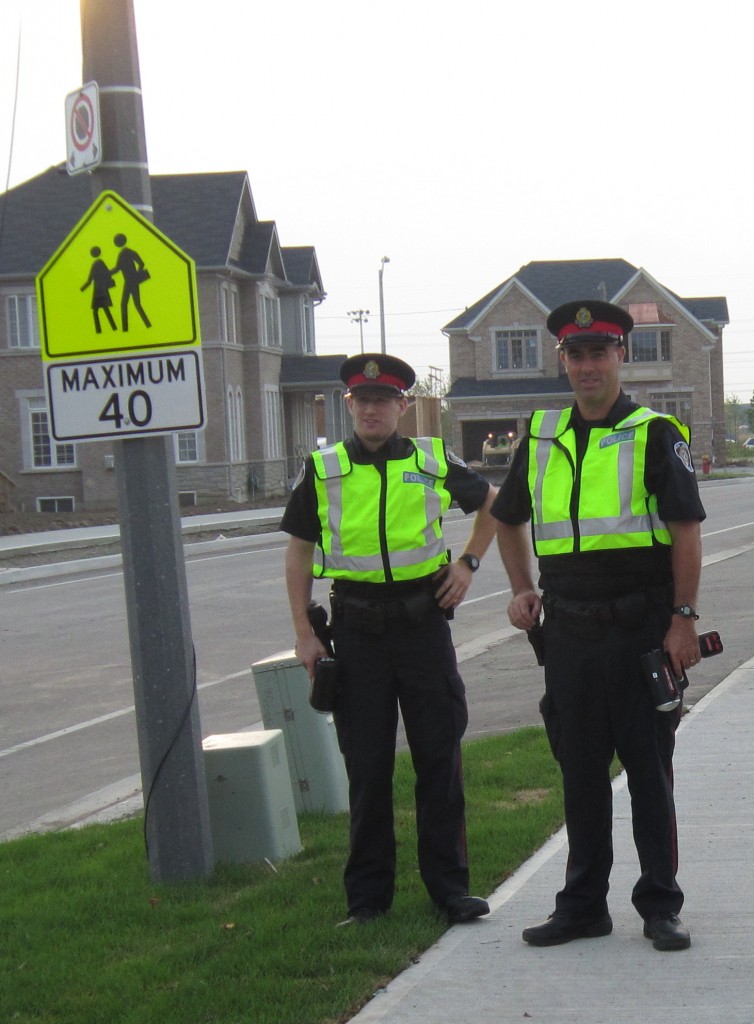 Signs are pretty clear. Police still nabbed 4 speeders speeders during an All Hands on Deck which had the Chief of Police out writing up tickets. The two officers shown here were kept busy. School zones should be safe zones. Enforcement will be on speeders, aggressive drivers, and the use of hand held devices while driving. Seatbelt compliance will also be strictly enforced. Frontline officers, District Response officers, Education Services officers, High School Liaison officers and Senior Command officers will all be taking part in this campaign.
On Thursday, September 8, 2016, Senior Officers, Specialist Units, Divisional Commanders and Police Executive officers will participate in the “All Hands on Deck” component of Project Safe Start.
This high visibility enforcement and education campaign will positively affect driver behaviour around school zones throughout the year and have overall lasting safety benefits to members of the community.
Halton residents have ranked traffic concerns as their #1 policing priority in surveys. Halton Regional Police Service recognizes this concern and engages in various campaigns throughout the year in efforts to educate the public and enforce the Highway Traffic Act and other traffic related legislation.
Pedestrians, cyclists, motorists and police all play an integral role in ensuring safer roads within the Halton Region. We ask that everyone do their part in ensuring our Region’s children return to school safely.
This may turn out to be a difficult day for some police officers who have to pull a driver over. In a recent report RoadWatch initiative police officers were abused and treated with little or no respect.
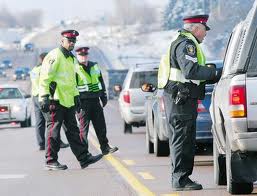 Police pulling cars over – and having to put up with abusive drivers. Were they carded? Here is a sample of the comments police reported:
• “Really…. I’m usually the first person to complain about that”
• “OH there’s a stop sign there?”
• “Just let me drive home, I just live around the corner a few blocks, I can make it” This driver failed a road side screening test and his licence was suspended
• “I guess there isn’t enough crime to keep you busy”
• “But I was just involved in a car accident the other day”
• “You’re a F……….. liar”
• “I was just holding it for directions”
• “Please we are very late for the train”
• “I’ve phoned and complained about the traffic on this street”
• “Sorry Officer I’m on my way to get my nails done”
• “I’m speeding because I have an infection and I’m on my way to shoppers to pick up the medication”
Over the course of the three days 371 traffic stops were initiated for Highway Traffic Act violations and 238 Provincial Offence Notices were issued.
The Gazette doesn’t understand why the police officers did not take the drivers into the station for a conversation.

 By Pepper Parr By Pepper Parr
August 29, 2106
BURLINGTON, ON
“We will make every vote count.” That was one of the election promises made when the country decided it had had enough of Stephen Harper and elected Justin Trudeau as Prime Minister.
“We are committed to ensuring that 2015 will be the last federal election conducted under the first-past-the-post voting system”, he said
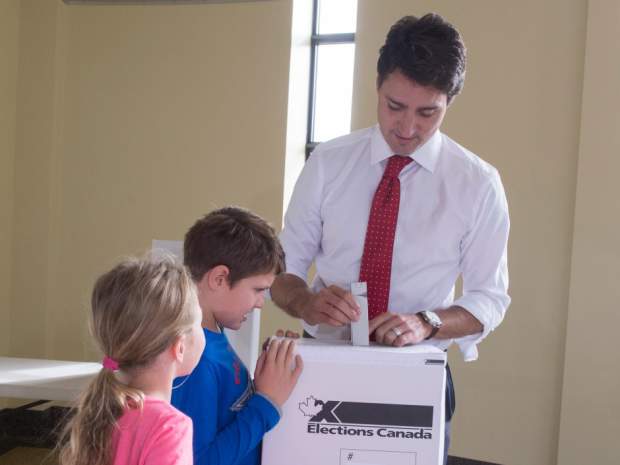 Then Liberal leader Justin Trudeau drops his vote in the ballot box as his daughter Ella-Grace and son Xavier look on. And added that: “We will convene an all-party Parliamentary committee to review a wide variety of reforms, such as ranked ballots, proportional representation, mandatory voting, and online voting.”
“This committee will deliver its recommendations to Parliament. Within 18 months of forming government, we will introduce legislation to enact electoral reform.”
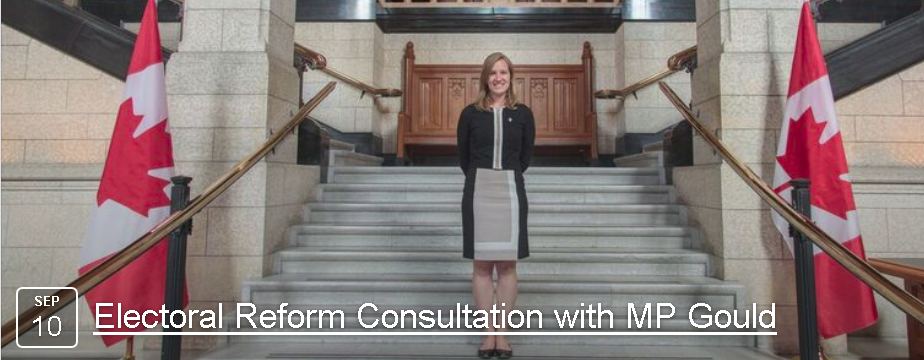 And that is what is behind a community meeting Burlington Member of Parliament Karina Gould is holding on Saturday September 10th at the Mainway Recreation Centre in the auditorium beginning at 12:30 and running until 3:00 pm And that is what is behind a community meeting Burlington Member of Parliament Karina Gould is holding on Saturday September 10th at the Mainway Recreation Centre in the auditorium beginning at 12:30 and running until 3:00 pm
The government created an all-party committee on electoral reform.
The Government’s main objective is to replace first-past-the-post with a system that will deliver better governments for all Canadians and asks the committee to focus on five key principles to get this done:
The link between voter intention and election results;
How to foster civility in politics and increase voter participation;
Steps to strengthen inclusiveness and accessibility;
Ways to safeguard the integrity of our voting system; and,
Taking into account local representation.
That is what the town hall meetings, which are being held across the country by at least all the Liberal Members of Parliament, are going to be about.
This is complex stuff; rife with the potential for “unintended consequences”.
Elections are about power and the right to govern want gets done with the public purse.
Starting tomorrow, Tuesday, the Gazette will publish a three part series on what the issues are; what the opportunities are as a background to understanding of what the issues are.
What are the options? In a series of articles Jay Fallis, a University of Toronto student who recently completed a Master’s degree in political science sets out some of the possible options. His three part series will begin tomorrow.

 By Ray Rivers By Ray Rivers
August 28, 2016
BURLINGTON, ON
Canada’s Lester Pearson won the Nobel Peace prize for his pioneering work in peacekeeping during the 1956 Suez crisis, a conflict which threatened to pit the US against fellow NATO members the UK and France.
Canada has been one of the strongest supporters of peacekeeping from that get-go. That is until the previous federal government and Mr. Harper virtually shut down the country’s contribution to UN peacekeeping operations and changed our global affairs perspective from honest-broker to aligned-party.
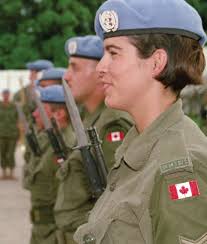 Canadian armed forces serving as United Nations Peacekeepers But then Mr. Harper had shunned the UN and it had in turn shunned Canada, shutting us out of a Security Council seat many thought would go to Canada. We once led the world with 3300 peacekeepers in the field, today there are just 34 – down to a mere one percent of our historic past. An all-time low at a time when the demand for UN peacekeeping operations is at an all-time high.
So, in keeping with the international re-engagement Mr. Trudeau promised during the last election, his government announced a dramatic reversal of previous policy, substantially increasing both financial support ($450 million) and peacekeepers (600). Ironically this announcement came on the very day that Mr. Harper announced his resignation from Parliament and politics.
In an article in this paper three years ago, I raised the fact that the Harper government had been supporting growth for Canada’s manufacture and export of arms, noting that this comprised the sum total of his industrial economic policy. There are a large number of armament exporters in the world. The USA, Russia, France and China dominate the international market.
The United NNations 2014 Arms Trade Treaty (ATT), governs the international trade in weapons for its signatories and restricts sales to nations which use them against their own populations. Over 130 nations have signed and almost 90 ratified this treaty but China, Russia and Canada have yet to do so. In addition there are UN nation-specific sanctions and arms embargoes which must be observed by all UN member nations. South Sudan and Libya are two sanctioned nations.
 It is an ugly brute of a vehicle that can only do harm to the people outside of it.
It was an unfortunate discovery that Streit, an Ontario company, had been selling armoured vehicles through a third party in 2014 to both of these nations. The federal Liberals were caught off-guard and holding the bag left them by the previous government. This became particularly embarrassing since it followed the Trudeau government’s refusal to disallow another Harper era mega deal to sell armoured vehicles to Saudi Arabia.
That deal, worth $15 billion dollars and negotiated in 2014, would make Canada the second largest arms supplier to the Middle East, after the USA. The hypocrisy was ripe when a former Tory cabinet minister, Tony Clement, raised the issue, presumably to embarrass the governing Liberals with the tricky dilemma over this lucrative job-creating deal that his government had negotiated.
It was a tough decision. After all it is hard to call yourself a peacekeeper when you are peddling weapons of war to the very people whose cross-fire may put you in harm’s way. So there were no tears by the federal Liberals to finally see the backside of Mr. Harper as he heads off for new employment better suited to his particular skills.
I didn’t disagree with everything he and his government accomplished in their time in office – but he was a disaster in foreign affairs, and that goes for his regressive policies in criminal justice and prison management as well.
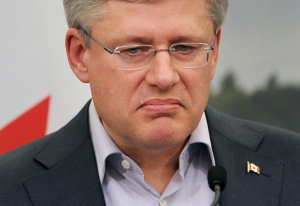 Former Prime Minister Stephen Harper. Mr. Harper presided over the poorest economic growth rate in Canada’s modern history. His efforts to water down environmental protection notwithstanding, he never built a single oil pipeline. His fixation with petroleum contributed to the economic collapse of his adopted home province. And not least of all, we should remember how he hid in a closet during that gun fight on the Hill.
The British government recently declassified a number of papers from the Foreign and Commonwealth Office, included in a link below. These are pretty frank depictions of how the Brits viewed our leaders in the eighties – Mulroney, Turner and Pierre Trudeau. Though nobody who lived through that era should be surprised.
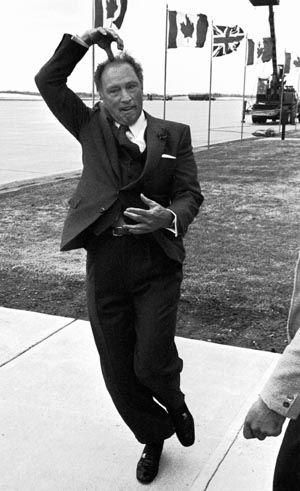 Former Canadian Prime Minister Pierre Trudeau is seen here performing a pirouette in Ottawa after the proclamation of the Constitution Act April 18, 1982. Despite all of Pierre Trudeau’s antics and progressive (radical) policies, what most worried them was his 1984 peace campaign. It is hard to understand how his naive bopping around world capitals on what ultimately became a hopeless venture would trouble anyone. How could seeking peace be dangerous? A “bloodless and over-intellectual approach” was their bottom line.
I suspect that Canadian diplomats had some equally choice words for Maggie Thatcher, as well. In the present day I would expect someone in our Global Affairs would point out that David Cameron was even more naive than Pierre in calling that stupid Brexit vote. I wonder how today’s British diplomats regard the younger Trudeau – the darling of the international press in his first year in office. He is flamboyant, but not quite like his father.
And I wonder how those foreign eyes would sum up Mr. Harper – other than to say, as I do, goodbye and good luck.
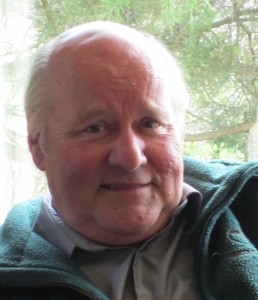 Ray Rivers Ray Rivers is an economist and author who writes weekly on federal and provincial issues, applying his 25 years of involvement with federal and provincial ministries. Rivers’ involvement in city matters led to his appointment as founding chair of Burlington’s Sustainable Development Committee. He was also once a candidate for public office at the provincial level.
Background:
Defence Industry – Streit – More Streit – South Sudan Sanctions – Saudi Weapons – Canada Exports to Mid-East – Burlington Gazette Oct 2013 – Abandon Peace Keeping –
Back into Peace Keeping – Suez Crisis – What UK Diplomats Really Thought –

 By Staff By Staff
August 26, 2016
BURLINGTON, ON
The debate continues but the marked bike lanes on New Street are almost ready to go.
One bike user gave it a go day before yesterday – he liked what he saw. It is a very quick trip – 49 seconds on a weekday.
We will have a look at the traffic on a weekday morning and in an evening as well and see what it looks like.
Keep in mind that this is a pilot project.
New Street road diet – video clip
The bike rider did say: “I was skeptical, but it’s nice – even if VERY bumpy!”

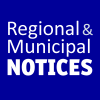 By Staff By Staff
August 26, 2016
BURLINGTON, ON
Burlington Transit announces an earlier start to Route 10 weekdays
Route 10, runs on New to Maple, will now starts earlier weekday mornings. It begins at Appleby GO station at 5:28 a.m.
An additional trip starting at 5:48 am has also been added.

|
|
 By Staff
By Staff















 Christopher has been missing since August 31st when he left his home heading for Prospect and Brant. He has not been seen or heard from by his family since which, for those who know this 23 year old, say “it is very much out of character”.
Christopher has been missing since August 31st when he left his home heading for Prospect and Brant. He has not been seen or heard from by his family since which, for those who know this 23 year old, say “it is very much out of character”.









 Jay Fallis is a graduate of the University of Toronto where he earned a Master’s Degree that focused on electoral reform.
Jay Fallis is a graduate of the University of Toronto where he earned a Master’s Degree that focused on electoral reform.








 Do you happen to know who this person is?
Do you happen to know who this person is?









 Teresa chose stained glass to express her artistic voice in 2001. Working full time as a stained glass Artist she opened the doors of Teresa Seaton Studio & Gallery in 2013. Teresa’s gallery features a large selection of her latest works and now exhibits the work of established and emerging Canadian artists.
Teresa chose stained glass to express her artistic voice in 2001. Working full time as a stained glass Artist she opened the doors of Teresa Seaton Studio & Gallery in 2013. Teresa’s gallery features a large selection of her latest works and now exhibits the work of established and emerging Canadian artists.

 The current 4:28 p.m. train departing Aldershot GO station will leave three minutes earlier at 4:25 p.m., affecting all station times along this trip.
The current 4:28 p.m. train departing Aldershot GO station will leave three minutes earlier at 4:25 p.m., affecting all station times along this trip.




 And that is what is behind a community meeting Burlington Member of Parliament Karina Gould is holding on Saturday September 10th at the Mainway Recreation Centre in the auditorium beginning at 12:30 and running until 3:00 pm
And that is what is behind a community meeting Burlington Member of Parliament Karina Gould is holding on Saturday September 10th at the Mainway Recreation Centre in the auditorium beginning at 12:30 and running until 3:00 pm









